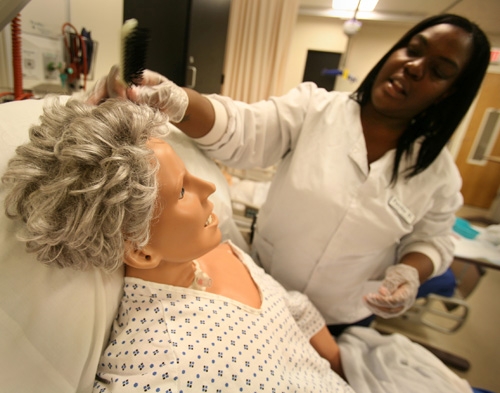College of Southern Nevada part of national nursing study

One of the fundamental questions in health care training is this: What is the best way to teach real-world skills to the people who will be poking and prodding the rest of us?
Is it better for students to practice on real people exclusively, or to get some experience practicing on pretend people too?
The College of Southern Nevada is part of a national study that aims to answer those questions.
Jan Kramer, the chair of CSN’s nursing program, said school officials expect that the simulations will end up as better teaching tools than real clinical experience.
With simulations, you can do things you’d never be able to do with real people.
“You can let the patient die,” Kramer said. “We can say, ‘You just killed your patient. This is what your actions led to.’ ”
CSN has the largest nursing program in Nevada, with more than 500 students. It educates about one-third of the state’s nurses. This fall, all students beginning the program will be part of the national study.
As it stands now, nursing students do classroom work and real-world clinical work at local health care facilities. They practice on real patients and, with supervision of course, treat whatever comes their way.
The study will replace some of that clinical experience with practice in a lab on lifelike mannequins. The mannequins are highly technical. They can speak and moan and exhibit whatever symptoms the professors wish them to simulate.
Need to teach about congestive heart failure? No problem. In the real world, it’s much more random than that.
A student could go through his or her entire training without coming across some of the most common real-world problems.
The study is being conducted by the National Council of State Boards of Nursing. It is the group responsible for developing state nursing license exams.
The group will study nursing students at 10 colleges and universities across the country, including Johns Hopkins University, Florida International University and Washington State University.
The study will follow new nursing students at each institution throughout their schooling. It will continue monitoring their work as professionals for a year after graduation.
The students will be randomly split into three groups: One group will work on simulators 10 percent of the time, another 25 percent and another 50 percent. The rest of the time will still be spent on real clinical experience.
According to a presentation from the nursing group, simulations have several potential advantages over clinical training.
Simulations can be customized, allow immediate feedback, can be reproduced and scheduled, and are safe.
Regardless of the study’s outcome, no more than 50 percent of the students’ clinical time would be replaced with simulated experiences.
The nursing group calls simulations a complement to clinical experience, not a substitute for it.
“We’re coming into a new age where we realize we can do much more with this equipment,” Kramer said.
Donna Enrico, who is coordinating the study at CSN, said being involved is very prestigious.
She said the demand for nurses is always high, and it is projected to get higher. As new nursing schools come online, space in health care facilities is getting harder to come by.
She said she is not worried that students will lose out by practicing on mannequins instead of real patients.
“The mannequins mimic humans in almost every way,” she said. “If they could get up and walk, they would.”
Contact reporter Richard Lake at rlake@reviewjournal.com or 702-383-0307.